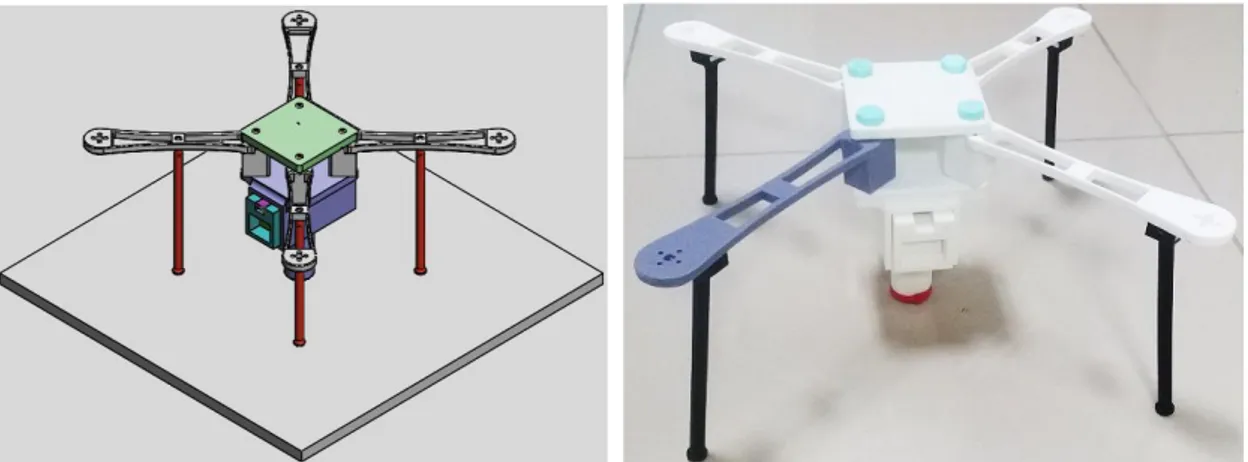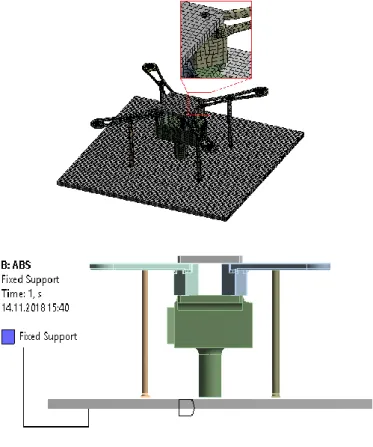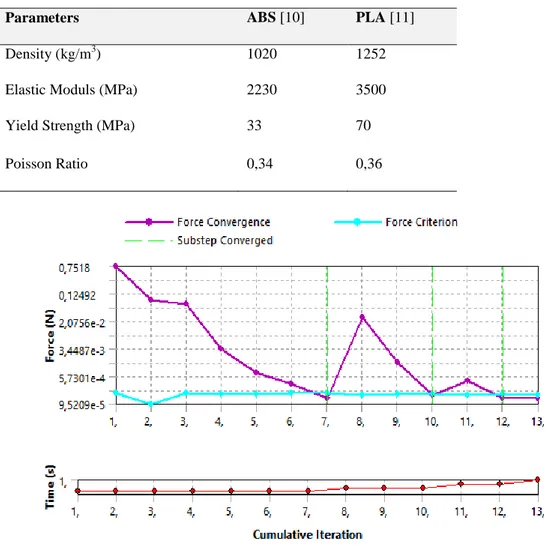RESEARCH ARTICLE
24
FINITE ELEMENT METHOD BASED STRUCTURAL ANALYSIS OF QUADCOPTER UAV CHASSIS PRODUCED WITH 3D PRINTER
Serkan ÇAŞKAi, Kadir GÖK2, Mustafa AYDIN3*, İkbal ÖZDEMİR4
1Celal Bayar University, Hasan Ferdi Turgutlu Faculty of Technology, Devision of Mechanical Engineering, Manisa,
serkan.caska@cbu.edu.tr, ORCID: 0000-0002-2157-8931
2 Bakırçay University, Faculty of Engineering and Architecture, Division of Biomadical Engineering, İzmir,
kadir.gok@bakircay.edu.tr, ORCID: 0000-0001-5736-1884
3 Kütahya Dumlupınar University, Faculty of Engineering, Division of Mechanical Engineering, Kütahya,
mustafa.aydin@dpu.edu.tr, ORCID: 0000-0002-9150-4081
4 Celal Bayar University, Hasan Ferdi Turgutlu Faculty of Technology, Division of Mechanical Engineering, Manisa,
181200001@ogr.cbu.edu.tr, ORCID: 0000-0002-6062-9973
Geliş Tarihi:11.06.2020 Kabul Tarihi:22.06.2020
ABSTRACT
In this study, the static analysis and manufacturing of a quadcopter type small unmanned aerial vehicle (UAV) design compatible with landing platforms was performed by using the finite element method. In static analysis, the weight of the quadcopter body is considered as the load and the base is fixed. Each part of the quadcopter used in the Finite Element Analysis (FEA) is manufactured with Acrylonitrile Butadiene Styrene (ABS) and Polyactic Acid (PLA) materials with a thickness of 0.05 mm with i3 prusa printer. As a result of the structural analysis, the stress produced in the quadcopter chassis produced from ABS material was 0,053 MPa and the stress on the quadcopter frame produced from PLA material was calculated as 0,065 MPa. In addition, the deformation in the quadcopter frame produced from ABS material was 0,014 mm, while the quadcopter frame produced from PLA material was 0,010 mm.
Keywords: 3D manufacturing, FDM, Quadcopter UAV, Finite element method 1. INTRODUCTION
Manufacturing methods are developing rapidly with technology. Traditional manufacturing methods are generally based on the principle of material removal from the workpiece [1,2]. Unlike traditional manufacturing methods, in additive manufacturing technologies, which have become more common in recent years, the basic principle is to add layers to the material, not to reduce parts from the material [1-5]. In controst to casting and injection molding method, there is no initial investment and maintenance cost in additive manufacturing technology [6,7].
In the last 10 years, the application area of 3D manufacturing have increased in the production of final products or visual prototypes in many different fields from dental implant production to the construction of engine parts. In recent years, the use of 3D printers has increased considerably due to the reduced costs and widespread use. The use of these devices is not limited to industrial facilities
Aydın, M., et. all.,Journal of Scientific Reports-A, Number 44, 24-32, June 2020.
25
and research institutes. The use of 3D printers has reached the individual user. Desktop 3D printers are widely used in homes or hobby workshops [7,8]. In recent researches realized in 2018, it was stated that ten different methods have been developed for 3D manufacturing technologies. These methods are Fused Depozition modeling (FDM), stereolithography (SLA), Digital Light Processing (DLP), Selective Laser Sintering (SLS), Direct Metal Laser Sintering (DMLS), Selective Laser Melting (SLM), Electron Beam Melting (EBM), Material Jetting (MJ), Drop on Demand (DOD) and Binder Jetting (BJ) [9]. In addition FDM method has a feasibility of desktop usage in recent years.
In the FDM method, thermoplastic or thermoplastic derivative materials are used as building materials. In this method, ABS, PLA and rarely composite based filaments are used [5-7]. ABS (Acrylonitrile Butadiene Styrene) is an oil-based polymer. It is an inexpensive material for low cost prototyping. However, it spreads toxic gases after burning with high temperature. Therefore, it should not be in contact with food [8]. PLA (Polylactic Acid) material is obtained from renewable resources. PLA material has a medium cost price and is an excellent 3D printer material [8]. PLA material is made from organic materials like renewable, corn starch or sugar cane. PLA material is often used to make food packaging, medical devices and implants [10]. FEA which is significant method used in structural analysis of engineering designs [12]. In recent years, FEA was used to analize the design of quadcopter chasis with PLA and ABS materials.
Today, there is a significant increase in applications related to the aerial surveillance system [13]. These systems are developed by companies that working with unmanned vehicles [14]. This study focused on strcutural analysis of a quadcopter chassis that is main simple component of aerial surveillance [15].
2. EXPERIMENTAL STUDIES 2.1. 3D Modeling and Analysis
In this study, the 3D model of a quadcopter unmanned aerial vehicle that is shown in Figure 1a. was created using the SolidWorks-2018. Computer-assisted analyzes were performed using AnsysWorkbench software. 3D CAD models were transfered into AnsysWorkbench software to prepare the finite element model. Load conditions, boundary conditions and material models are defined in AnsysWorkbench. In Figure 1b, the quadcopter chassis produced with PLA material by using FDM method is shown.
Aydın, M., et. all.,Journal of Scientific Reports-A, Number 44, 24-32, June 2020.
26
Quadcopter has 6 degree of freedom and its dynamic model has 6 equations of movement. Dynamic model of the quadcopter includes virtual inputs composed by angular velocities of rotors. The angular velocities (ωi) of the rotors are the real input variables of the quadcopter UAV. However, at the
mathematical model is used virtual inputs that consisting of angular velocities. Virtual inputs are given in equations 1-4.
(1) (2)
(3) (4) In equations 1-4, u1 is the thrust force acting on the body of the quadcopter, u2 is the force that generates the rolling torque, u3 is the force that generates pitching torque, u4 is the force that generates the turning torque. Dynamic model quadcopter was shown in equations 5-10. In this equations, d (drag) is impact factor. L is distance from the propellers to the center of the quadcopter, m is total mass of quadcopter. are moment of inertia on basic axes.
In Table 1, was given parameters and values of parameters that used in mathematical model design of quadcopters.
Table 1. Value of parameters used in the mathematical model of quadcopter.
Parameter Value(PLA) Value(ABS)
g 9,81 m/s2 9,81 m/s2 m 0.81 kg 0.65 kg L 0.25 m 0.25 m 𝑢1= (𝜔12+ 𝜔22+ 𝜔32+ 𝜔42) (𝑢2= (𝜔12− 𝜔32) 𝑢3= (𝜔22− 𝜔42) 𝑢4= (𝜔12− 𝜔22+ 𝜔32− 𝜔42) 𝑥̈ = (𝑐𝑜𝑠𝜓𝑠𝑖𝑛𝛳𝑐𝑜𝑠𝜑 + 𝑠𝑖𝑛𝜓𝑠𝑖𝑛𝜑)𝑢1 𝑚 (5) 𝑦̈ = (𝑐𝑜𝑠𝜓𝑠𝑖𝑛𝛳𝑠𝑖𝑛𝜑 − 𝑐𝑜𝑠𝜓𝑠𝑖𝑛𝜑)𝑢1 𝑚 (6) 𝑧̈ = −𝑔 + 𝑐𝑜𝑠𝛳𝑐𝑜𝑠𝜑𝑢1 𝑚 (7) 𝜑̈ = 𝛳̇𝜓̇ (𝐼𝑦−𝐼𝑧 𝐼𝑥 ) + 𝐿 𝐼𝑥𝑢2 (8) 𝛳̈ = 𝜑̇𝜓̇ (𝐼𝑧−𝐼𝑥 𝐼𝑦 ) + 𝐿 𝐼𝑦𝑢3 (9) 𝜓̈ = 𝛳𝜑̇̇ (𝐼𝑥−𝐼𝑦 𝐼𝑧 ) + 𝑑 𝐼𝑧𝑢4 (10)
Aydın, M., et. all.,Journal of Scientific Reports-A, Number 44, 24-32, June 2020.
27
Ix 0.0132 kg m2 0.0104 kg m2 Iy 0.0132 kg m2 0.0104 kg m2 Iz 0.0257 kg m2 0.0205 kg m 22.2. Loading and Boundary Conditions
Meshing was performed by using a hex-dominant finite element type for FEA as shown in Figure 2. The FEA model has 323719 nodes and 82601 elements. Element size was chosen to 5 mm. Total weight of the quadcopter have considered as load. Quadcopter was fixed on the base surface as shown in Figure 3.
Mechanical properties of ABS and PLA plastic materials are given in Table 2. These values was taken from library of AnsysWorkbench. Soil was selected from Ansys Workbench material library for floor [8]. Convergence analysis is shown in Figure 4 [9].
Figure 2. Mesh structure of quadcopter chassis.
Aydın, M., et. all.,Journal of Scientific Reports-A, Number 44, 24-32, June 2020.
28
Table 2. Mechanical properties of materials used in FEA.Parameters ABS [10] PLA [11]
Density (kg/m3) 1020 1252
Elastic Moduls (MPa) 2230 3500
Yield Strength (MPa) 33 70
Poisson Ratio 0,34 0,36
3. EXPERIMENTAL RESULTS
Finite element analyzes were performed after the loading and boundary conditions were defined. When quadcopters land on to soil ground, stress that was shown in Figure 5 was consisted with impact of its weight. Deformation that consisted with impact of its weight was shown in Figure 6. In Figure 5 and Figure 6. As a result of the structural analysis, the stress occured in the quadcopter chassis designed with ABS material was 0,053 MPa, whereas design with PLA material was calculated as 0,065 MPa. In addition, the deformation in the quadcopter frame designed with ABS material was 0,014 mm, while the quadcopter frame desigend with PLA material was 0,010 mm. In Table 3, stress and deformation values are given.
Aydın, M., et. all.,Journal of Scientific Reports-A, Number 44, 24-32, June 2020.
29
Figure 5. Tensile values, a) produce of ABS material, b) produce of PLA material.
Aydın, M., et. all.,Journal of Scientific Reports-A, Number 44, 24-32, June 2020.
30
Table 3. Deformation and stress values for quadcopter chasis.
Material Stress (MPa) Deformation (mm)
ABS 0,053 0,014
PLA 0,065 0,010
4. CONCLUSION
PLA material has a high modulus of elasticity and a high yield strength. Therefore, when contacting on the ground with a load of quadcopters own weight, strains occur at the contact points of the arms. These stresses are higher stresses according to ABS material. The modulus of elasticity is inversely proportional to elastic deformation as is seen in equation 11 and equation 12. The modulus of elasticity is the resistance of the material to elastic deformation. Therefore, PLA that have high modulus of elasticity is expected to constitute lower deformation.
𝐸 =𝜎ɛ (11)
𝜎 = 𝐸. ɛ (12)
The stresses (0,053 MPa ve 0,065 MPa) formed in the quadcopters designed with materials ABS and PLA are very low ((ABS, 𝜎𝑎𝑘= 33 𝑀𝑃𝑎), (PLA, 𝜎𝑎𝑘= 70 𝑀𝑃𝑎)). Since the stresses that occur in analysis did not exceed yield strength of material, any damage wasn’t comprise in both designs. However, PLA material is economical, it does not create toxic materials during manufacturing, it prints without using table heating during printing and creates lower deformation during printing. Therefore, it has been determined that it is more appropriate to use filament obtained from PLA material.
ACKNOWLEDGEMENT
This study was carried out within the scope of project numbered 2018-067 supported by Manisa Celal Bayar University Scientific Research Projects Coordination Unit.
REFERENCES
[1] Cong, W., Ning, F., Qiu, J., Wang, S. Wei, J. (2015). Additive Manufacturing Of Carbon Fiber Reinforced Thermoplastic Composites Using Fused Deposition Modeling. Composites Part B: Engineering, 80, 369-378.
[2] Cronin, L., Dragone, V., Kitson P.J., Rosnes M. H., Sans, V. (2012). Configurable 3D-Printed Millifluidic And Microfluidic ‘Lab On A Chip’ reactionware Devices. Lab On A Chip, 12(18), 3267-3271.
Aydın, M., et. all.,Journal of Scientific Reports-A, Number 44, 24-32, June 2020.
31
[3] Cronin, L., Dragone V., Kitson P. J., Symes M. D. (2013). Combining 3D Printing And Liquid Handling To Produce User-Friendly Reactionware For Chemical Synthesis And Purification. Chemical Science. 4(1), 3099-3103.
[4] Bhowmik, J. L., Masood, S. H., Mohamed, O. A. (2017). Experimental İnvestigation Of Time-Dependent Mechanical Properties Of PC-ABS Prototypes Processed By FDM Additive Manufacturing Process. Materials Letters, 193, 58-62.
[5] Aydın, M., Çantı, E., Yıldırım, F. (2018). Production and Characterization of Composite Filaments for 3D Printing. Journal Of Polytechnic, 21(2), 397-402.
[6] Beamud, E., García-Plaza, E., Nuñez, P. J., Rivas, A., Sanz-Lobera, A. (2015). Dimensional And Surface Texture Characterization İn Fused Deposition Modelling (FDM) With ABS Plus. Procedia Engineering, 132, 856-863.
[7] Aydın, M., Çantı, E. (2018). Effects Of Micro Particle Reinforcement On Mechanical Properties Of 3D Printed Parts. Rapid Prototyping Journal, 24(1), 171-176.
[8] Aydın, M., Çantı, E., Yıldırım, F. (2019). Farklı Yazdırma Parametrelerinde PLA Filamentin İşlem Performansının İncelenmesi. International Journal Of 3d Printıng Technologies And Digital Industry, 3(2), 102-115.
[9] Çankaya, A., Güldaş, A., Güllü, A., Gürü, M. (2014). Çinko Borat Katkılı Polipropilen’in Reolojik Özelliklerinin Belirlenmesi. Gazi Üniversitesi Mühendislik-Mimarlık Fakültesi Dergisi, 29(2), 227-234.
[10] Rodríguez, J. F., Thomas, J. P., Renaud, J. E. (2001). Mechanical behavior of acrylonitrile butadiene styrene (ABS) fused deposition materials. Experimental investigation. Rapid Prototyping Journal, 7(3), 148-158.
[11] Farah, S., Anderson, D. G., Langer, R. (2016). Physical and mechanical properties of PLA, and their functions in widespread applications — A comprehensive review. Advanced Drug Delivery Reviews, 107,367-392.
[12] Gök, K., Gülbandılar, E., İnal, S., Taşpınar, F. (2015). Comparison Of The Biomechanical Effects Of Pertrochanteric Fixator And Dynamic Hip Screw On An İntertrochanteric Femoral Fracture Using The Finite Element Method. The International Journal Of Medical Robotics And Computer Assisted Surgery, 11(1), 95-103.
[13] Çaşka, S., Gayretli, A. (2014). A Survey Of UAV/UGV Collaborative Systems. CIE44&IMSS’14 Proceedings, pp.453-463, İstanbul.
[14] Filho, P., Morrison, J. R., Suzuki, K. A. O. (2012). Automatic Battery Replacement System For Uavs. Analysis And Design. Journal Of Intelligent And Robotic Systems, 65(1-4), 563-586. [15] Fujii, K., Higuchi, K., Rekimoto, J. (2013). Endless Flyer: A Continuous Flying Drone With
Aydın, M., et. all.,Journal of Scientific Reports-A, Number 44, 24-32, June 2020.
32
& Computing And 2013 IEEE 10th International Conference On Autonomic & Trusted Computing, pp. 216-223, Vietri sul Mere.





